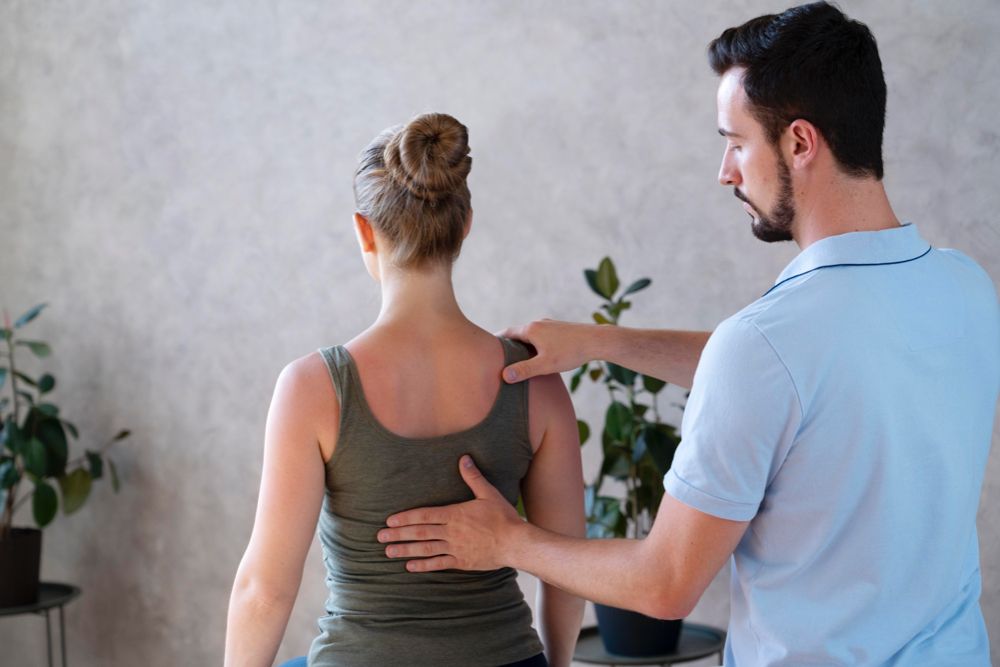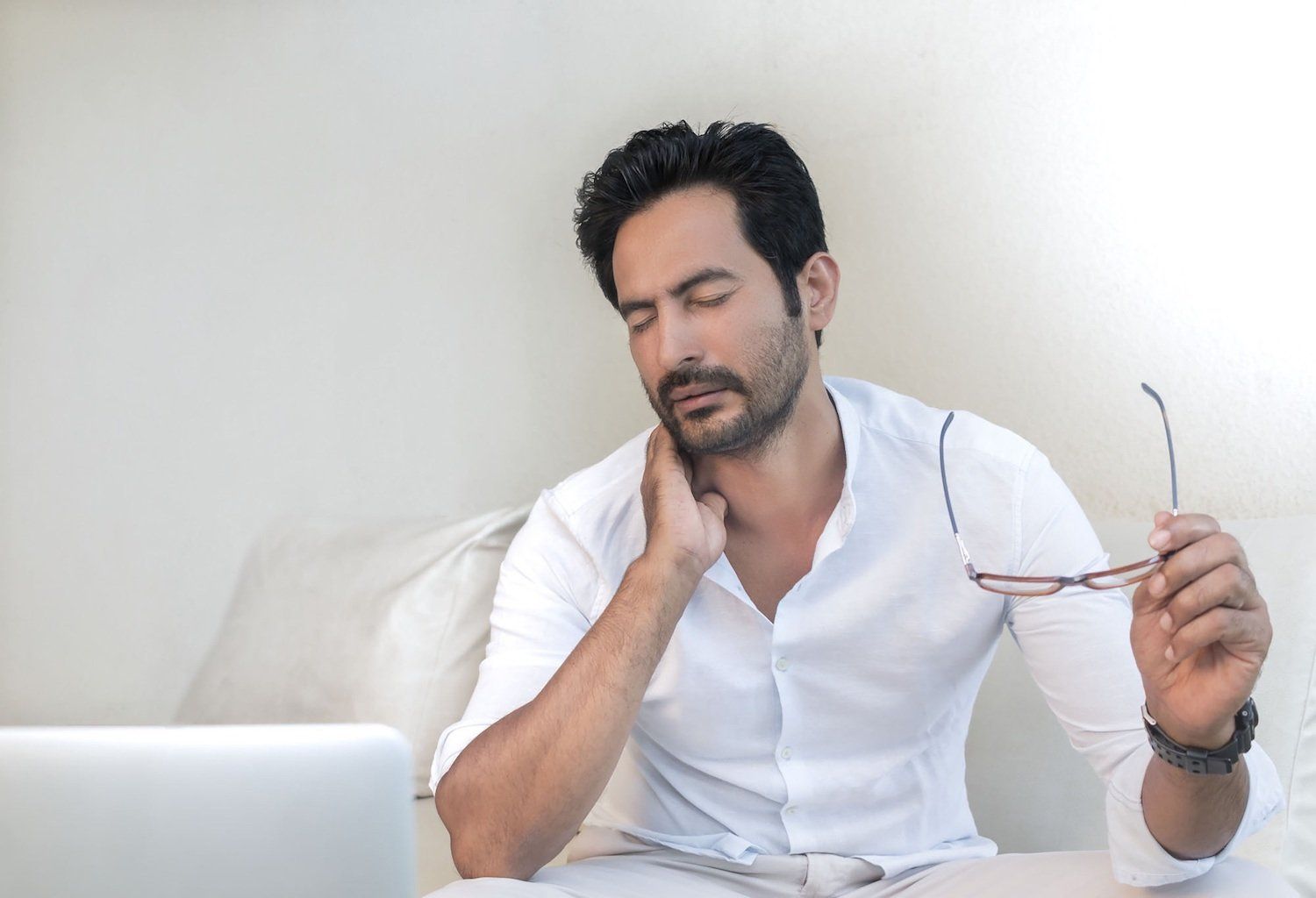
Mgr. Vojtěch Šenkýř
I am a physical therapist and personal trainer. In the hospital and in the gym, I mainly rely on the Kolář DNS technique. I'm currently also learning the Vojta technique.
Other articlesLog in

Satisfaction with a job well done. For many of us a key source of motivation for going to work every morning, right up there with the money and a good team. But this satisfaction can easily be overshadowed by the pain of a repetitive strain injury, a typical example of which is carpal tunnel syndrome.
In my years as a physical therapist, I’ve seen many patients suffering from CTS. Whether you’re among them or just want to avoid joining them, this article attempts to clarify the issue and provide practical advice.
The carpal tunnel (canalis carpi) is a part of the wrist where veins, nerves, and tendons pass from the forearm to the palm. It is an osteofibrous (bone-and-ligament) passage formed between the carpal (wrist) bones on one side and a tough transverse ligament (the retinaculum flexorum) on the other (Gross et al., 2005).
A total of nine digital flexor (finger-bending) tendons and the medianus nerve run through the carpal tunnel. A healthy carpal tunnel provides both protection and adequate space for these structures. (Rychlý, 2002).
The carpal tunnel is found in the wrist. The osseous (bone) structure of the wrist consists of several carpal bones, which together form a dorsally convex, ventrally concave arc. (That is, an arc bent outward at the back of the hand, and inward on the palm side.) The palm-side cavity is covered by a stiff transverse ligament (Gross et al, 2005).
Interestingly enough, the carpal tunnel doesn’t have any muscles, only the flexor tendons. There tendons are, however, each encased in a separate inner sheath, then a common outer sheath for the finger flexors and a separate one for the thumb. These structures can become inflamed, in which case they swell and cause painful compression (Mrzena, 2005).
Carpal tunnel syndrome is by far the most common mononeuropathy (peripheral nerve condition), as well as the most common professional disease in many regions. It is a compressive neuropathy of the wrist, caused usually either by long-term, one-sided excessive loading of the hand and wrist, or the long-term exposure of the area to vibrations. It can also be caused by certain organic conditions, such as renal (kidney) dysfunction, a thyroid problem, or diabetes (Minks, 2014).
The earliest description of a pinched nervus medianus in the wrist is by Sir James Paget in 1854 (Smrčka, 2007).
The felt symptoms are most often a pins-and-needles sensation or numbness in the fingers (not the thumb); there is also a measurable shrinking of the thenar eminence (the muscle bulge at the inner base of the thumb).
In the early stages, the first symptom tends to be nighttime paresthesis (pins-and-needles or burning sensation) of the four fingers, which usually wakes patients early in the morning. Sufferers commonly shake out their hands, which brings relief. In advanced stages, the sensitivity and eventually motor function of the thumb deteriorate, and the thenar bulge atrophies. Diagnosis can be made by Tinel’s sign (pain elicited by tapping in the pinched nerve area), Phalen’s sign (pain from keeping wrist bent for one minute), and painful compression in the carpal tunnel area. The extent of damage can be ascertained by electromyography (EMG) (Navrátil, 2012).
A wide variety of factors may contribute to the development of carpal tunnel syndrome, including repetitive external strain or damage (e.g. work on a computer or with a jackhammer), increased water retention and susceptibility to swelling due to pregnancy or thyroid hypofunction, increased interior pressure in the carpal tunnel due to rheumatoid arthritis or other inflammation, or increased sensitivity to external pressure due to certain metabolic disorders (diabetes, urea cycle disorders) (Smrčka, 2005).
Before therapy can begin, a thorough and accurate diagnosis needs to be made.
The key diagnostic elements are detailed anamnesis (talking to a physician about one’s work, sports, any other diseases that may relate to the problem, etc.) and clinical examination. In the latter, the patient performs specific motions with the hand or certain points are tapped on to see whether any of it elicits pain.
Imaging methods include X-ray, which will show any pathological changes to the wrist skeleton (e.g. left by prior wrist or lower forearm fracture). Computed tomography (CT) can fairly accurately measure the size of the osseous part of the carpal tunnel. Ultrasound imaging will show the width and composition of the medianus nerve (e.g. swelling changes). Magnetic resonance imaging (MRI) can determine the degree and extent of damage to the n. medianus in the carpal tunnel area.
The essential technological examination is by electromyography. This will show whether the nerve’s ability to conduct signals is impaired, which would point to pinching or other damage. In practice, the examination consists of placing electrodes on the patient’s arm, through which the EMG machine passes a small electrical charge. Based on the conduction of the charge, the EMG evaluates whether a nerve is damaged or not. The electrical pulses can be mildly uncomfortable.
Once reliable diagnosis of carpal tunnel syndrome has been made, it is time to begin addressing this potentially unpleasant condition.
The starting point of any treatment is proper diagnosis and determination of possible causes. Given that many other conditions (in particular, cervical spine and muscle problems) present with similar symptoms, it is best to see an expert (physical therapist or physician) without delay, in order to receive an accurate diagnosis and effective treatment suggestions. Patients attempting to self-medicate at home may end up wasting money on treatments that fail to improve their particular condition.
If you or your physician believe a medicinal ointment might be of help, this is certainly the simplest solution. There are a wide variety of medications (antirheumatics, antiphlogistics, antipyretics, analgesics, etc.) your pharmacist may propose. Depending on the particular product chosen, the mechanism of function is usually to reduce the inflammation, swelling, or pain at the site of application. It must be noted that these creams are rarely effective beyond the condition’s early stages, and that for them to be effective at all requires the patient to concurrently address the ultimate cause (e.g. switch to an ergonomic mouse or mousepad, improve posture during work tasks, limit exposure to vibrations, etc.).
Physical therapy uses various forms of energy to achieve therapeutic effect. Most commonly motor energy, i.e., exercise. Other energies used include thermal (peat, UV lamps, cryotherapy), mechanical (ultrasound), electromagnetic (infrared, laser), or electrical (electropulse therapy). Physical therapy usually aims to resolve ultimate causes rather than manage symptoms. A physical therapist visit usually begins with anamnesis, i.e., a chat about your work, medication taken, any other conditions you may have, what positions you relax in, etc. This is followed by a musculoskeletal and basic neurological examination. On that basis, the physical therapist determines a diagnosis and proceeds to treatment with various stretching and mobilization motions for tendons, bones, and joints, sending you home with exercise recommendations. An overloaded wrist can also be treated with kinesiology tape, which provides some mechanical support and swelling relief.
If the “conservative” treatments listed above fail to resolve the problem, there is the option of analgesic injections (e.g. corticosteroids) directly into the pain site, which may reduce swelling and pain. If those fail to help as well, the final, invasive but usually effective option is surgery.
There are several surgical approaches to carpal tunnel syndrome, with the standard one being section of the tendon compressing the nerve. The section is 20 to 30 mm (about an inch) long, depending on hand size. This is usually an outpatient procedure with local anesthetics. The aim is to reduce pressure put on the medianus nerve by the tendon, which by this point in the condition is permanently engorged.
If you want to avoid the problems and therapy described above, there are several practical recommendations. First off, if you have pain anywhere, do something about it right away and avoid the extreme case of surgery. As stiff, unsuitable seated posture at a computer and unergonomic use of the mouse are now among the leading causes of carpal tunnel syndrome, let’s take a look at them in particular.
Spending most of the day hunched, with shoulders jutting forward, head bent, and loose abs will sooner or later cause some sort of problem. How can poor seated posture overload the wrist? If a joint is decentered (out of optimal position), its movements are inefficient, and in the long term this causes overload of related tendons.
In a proper seated (or standing) posture, the head should be extended straight up, shoulders hanging loose, spine naturally curved, pelvis tilted slightly forward. Optimal seated posture primarily requires the proper positioning of the head and pelvis. A computer screen needs to be set high enough to be usable without bending the head down. On the other hand, the screen should not be so high as to require tilting the head back.
Much like a house needs a solid foundation, the body needs a solid core of torso muscles. These are essential for supporting the back, and their poor function leads to joint decentering and, ultimately, problems like carpal tunnel syndrome. Active sitting such as is possible with Adaptic chairs keeps core muscles engaged, which is very helpful for proper posture.
Another essential requirement for preventing carpal tunnel syndrome is proper posture of the hand when working with a mouse. If the hand and wrist are chronically overloaded, swelling and inflammation occur, which may cause carpal tunnel syndrome. Fortunately, ergonomic aids for proper hand posture in computer work have become common, including e.g. Adaptic’s A+ Wrist pad (link in Czech).
The final key aspect of carpal tunnel syndrome prevention is the proper exercise. This should generally combine stretching and strengthening moves, ideally in positions derived from early childhood development (this is the principle of e.g. the Kolář DNS system or the Vojta Technique).
You can also get inspired in this video I made for my patients:
The regimen is individually set by your surgeon and the physician or physical therapist in charge of your rehabilitation. Generally it consists of gradually exercising the hand and wrist back to full mobility. After the stitches are removed, the first phase is relaxing the area of the scar, mobilizing the fingers, and practicing low-power grabbing motions to reduce swelling. Once the surgeon gives clearance, the patient may begin putting weight (leaning) on the hand and exercising with light weights or a resistance band. In some cases, laser resurfacing may be used to reduce the prominence of the scar.
assuming the condition is in its early stages and the primary cause of wrist overloading is removed, a suitable exercise regimen can reduce or even completely eliminate carpal tunnel symptoms. The more advanced the condition is, the less likely it will respond to exercises alone.
Carpal tunnel syndrome has numerous symptoms, pain being the most common. You may also have a pins-and-needles sensation, reduced sensitivity or mobility, and other problems.
Massages are generally pleasant, and reduce stress as well as muscle tension; lymphatic drainage massages even reduce swelling. For all these reasons, massage can certainly be helpful in preventing carpal tunnel syndrome. Assuming the primary cause of the syndrome is eliminated, massage combined with rehabilitation can also help treat its early-stage forms.
I am a physical therapist and personal trainer. In the hospital and in the gym, I mainly rely on the Kolář DNS technique. I'm currently also learning the Vojta technique.
Other articles


